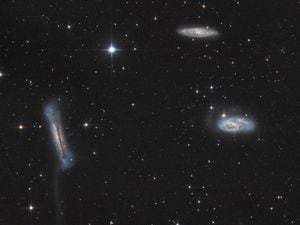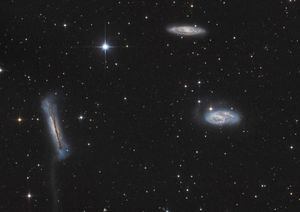Shropshire Sky At Night – April
The major planets gather in the pre-dawn sky to deal up two very close and special planetary conjunctions this month.

A conjunction occurs when two or more planets appear close to each other in the night sky – although it is an optical illusion as, in reality, they are very far away from each other.
April 5 sees Mars and Saturn very low down on the south eastern horizon. They will not be easy to spot, so a pair of binoculars may come in handy.
This is followed on the 29th by Venus and Jupiter. These two bright object should be easily identified close to the eastern horizon, where they can be spotted for a couple of days before sunrises.
For the second half of the month elusive Mercury shrugs off its shyness, as it appears out of the Sun's glare in the evening sky. The planet is always at its brightest at the beginning of evening apparitions, which helps you spot it close to the NWN horizon. Just be safe and wait for the Sun to set before scanning the sky.
Uranus, the seventh planet from the Sun, is best sought in the first two weeks of the month before it joins Neptune with its date with the Sun.
It is an excellent year for observing the maximum of the Lyrids Meteor Shower which can produce up to 20 meteors per hour at its peak. It is produced by dust particles left behind by comet C/1861 G1 Thatcher, which was discovered in 1861.
The shower runs annually from April 16 to 25, peaking this year on the night of the 22nd and morning of the 23rd. These meteors can sometimes produce bright dust trails that last for several seconds. The waning gibbous moon is a late riser so there is potential for a good show. Best viewing will be from a dark location after midnight. Meteors will radiate from the constellation Lyra, but can appear anywhere in the sky.
Leo is one of those rare constellations that remind you of the real thing, in this case a crouching lion, which honours the formidable beast that Hercules killed as the first of his 12 labours, as instructed by the Greek god Apollo.
Regulus, a first magnitude star, marks the lion's heart and can easily be seen at the base of the backwards question mark (the Sickle) outlining the shoulders, neck and head of Leo. A small telescope or pair of binoculars will easily identify Algieba, the star that makes up the lion’s shoulder, a beautiful double star, while Denebola marks the other extremity of Leo (the tail).
Stretching underneath the big cat's belly is a clutch of spiral galaxies, including what is referred to as the Leo Triplet, found towards the tail, popular viewing in the spring.

Stretching underneath the big cat's belly is a clutch of spiral galaxies, including what is referred to as the Leo Triplet, found towards the tail, popular viewing in the spring. All three are large spiral galaxies but they tend to look dissimilar because their galactic disks are tilted at different angles to our line of sight, and very popular with imagers.
Steve Szwajkun FRAS, Shropshire Astronomical Society





